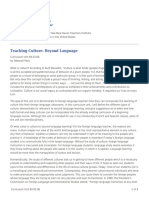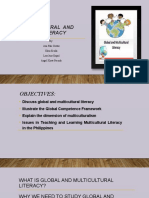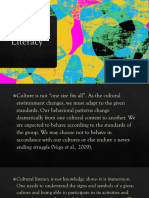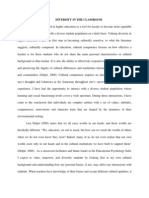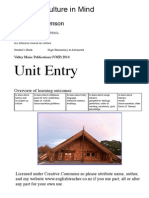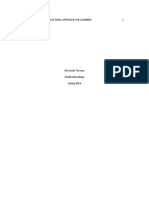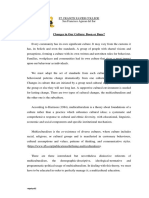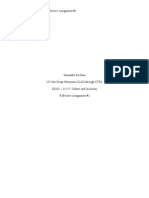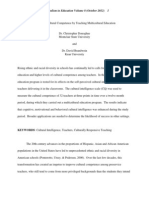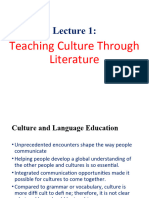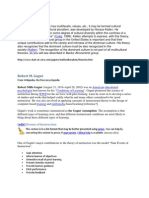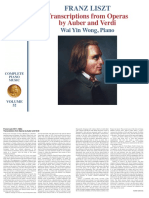0 ratings0% found this document useful (0 votes)
48 viewsDiana Tejero SFE Essay
Diana Tejero SFE Essay
Uploaded by
Patrícia Nadal MatllerETHNIC INEQUALITY: an analysis of two situations that try to empower a minoritarian identity in the USA.
Essay for Sociology course at Secondary School Teacher Master's Programme
Copyright:
© All Rights Reserved
Available Formats
Download as PDF, TXT or read online from Scribd
Diana Tejero SFE Essay
Diana Tejero SFE Essay
Uploaded by
Patrícia Nadal Matller0 ratings0% found this document useful (0 votes)
48 views4 pagesETHNIC INEQUALITY: an analysis of two situations that try to empower a minoritarian identity in the USA.
Essay for Sociology course at Secondary School Teacher Master's Programme
Original Title
Ethnic Inequality
Copyright
© © All Rights Reserved
Available Formats
PDF, TXT or read online from Scribd
Share this document
Did you find this document useful?
Is this content inappropriate?
ETHNIC INEQUALITY: an analysis of two situations that try to empower a minoritarian identity in the USA.
Essay for Sociology course at Secondary School Teacher Master's Programme
Copyright:
© All Rights Reserved
Available Formats
Download as PDF, TXT or read online from Scribd
Download as pdf or txt
0 ratings0% found this document useful (0 votes)
48 views4 pagesDiana Tejero SFE Essay
Diana Tejero SFE Essay
Uploaded by
Patrícia Nadal MatllerETHNIC INEQUALITY: an analysis of two situations that try to empower a minoritarian identity in the USA.
Essay for Sociology course at Secondary School Teacher Master's Programme
Copyright:
© All Rights Reserved
Available Formats
Download as PDF, TXT or read online from Scribd
Download as pdf or txt
You are on page 1of 4
Diana Tejero
SFE Essay
ETHNIC INEQUALITY: an analysis of two situations that try to
empower a minoritarian identity in the USA
Nowadays the world is becoming a cultural melting pot. Conflicts, migrations,
economy and the facility to travel generate a diverse mixture of cultures that co-exist in
different places in the planet. But that co-existence is not always easy: understanding
the difference is a matter that has to be taught together with the own culture to be able
to accept the people that are around oneself.
Education has the power to give us the tools to understand who we are and how
the world around us works, that is why it is so important to give an education based on
values as tolerance, respect, understanding and self-appreciation. However, when it is
put into practice it is difficult to follow all these principles and sometimes the measures
that are carried out do not exactly guarantee the transmission of these values.
In this essay I want to analyze two examples where ethnic equality/inequality is present
in different educational situations: two projects carried out in schools in USA to
empower latino students’ identity.
A “new culture” is being created in the world, it is a global culture, generated by
the phenomena of globalisation in the world. It is a culture of the WEIRD, Western,
Educated, Industrialised, Rich and Democratic, a term invented by Joseph Heinrich to
refer to the people who are the main subjects to psychology studies. The
western-educated people is expanding as the global culture and the people belonging to
minor cultures are losing the traces of their identity, especially when this conflict takes
place in the WEIRD’s country.
An example of this is the Latino/Mexican population in the USA. It is well-known
that in the USA there are many people with different racial and ethnic origin and that
most of that people are not integrated in the main culture. During my time in the USA I
could see an obvious separation between the main culture and the minoritarian ones in
the kind of jobs they had, the parts of the city they lived in, the schools they attended
to…
The process of acculturation takes places gradually and even if it is a two-way
process most of the times implies a minoritarian culture adjusting and adapting to a
majority. This process is not only about the changes that can be noticed externally but
about the psychological processes that the subjects of acculturation experiment inside.
Ideally this process should result in a cultural integration but it is complex and generally
assistance is needed to help the minoritarian culture improve their self concept and
don't feel like they are losing their original identity.
The FRESA project and the "Aquí y allá" workshop were carried out in Oregon
and in California and both were designed to invite their Primary school students to get to
know their own culture and their peers' and to express through it. The main goals turned
around empowering the students who belonged to a minoritarian culture and the ones
from the main culture to express through it, to promote critical thinking and create an
anti-racist environment and to integrate the second language acquisition, thus the
groups that took part in the project were both part of a bilingual program.
In the FRESA project the teachers and the students together carried out a
research about the ways of sustaining the local community. It is called FRESA because
there are many strawberry fields surrounding the area and the parents of a lot of the
latino origin kids work in that fields. This kind of job is seen as a job for the poor people
and through the project they wanted to bring awareness about the work that takes place
in the fields, the relationship of this jobs with the local economy and how the daily life of
the workers are in order to give a better idea of it and improve the appreciation of it.
Through interviews to the parents, Internet research and observing and gathering
information about their surroundings all the kids created a project that was shared within
the school, the local community and in their homes.
Improving the self-concept of the kids helps to bring awareness of cultural
diversity and recognition of the different realities that co-exist in a place. Achieving the
level of integration of one culture and another is a complex process that implies a good
co-existence between the cultures, the respect for the difference and the finding of
common principles that both cultures can share. For instance, the FRESA project
doesn’t only help the kids be more aware but also creates an exchange of experiences
with the families and the other community members, making them participate in it
somehow.
Another example of the attempts carried out in education to integrate a
minoritarian culture within a bigger one is the Aquí / Allá poetry unit. Elizabeth
Schlessman, a 5th grade teacher in a school in Woodburn, Oregon used the poems of
Jorge Argueta to teach her students about cultural differences, identity and expression
of the self through a literature unit based on poetry.
It is common to find an ethnic minority living in a foreign country and
experiencing a different culture while longing for their original place and traditions. This
is part of the stage of separation, where the individuals fear the difference and are afraid
of not being accepted in the new culture.
“Breaking down a model, building up a draft” are the words Elizabeth used to
express the idea of integrating two cultures: observing the differences, understanding
them and creating a new model that belongs to the two cultures, thus, intercultural
situations affect to the two cultures, the travelling one and the receiving one.
In the poetry unit the students had to choose two different places they liked and
list different qualities of them. Some of the students in that class had Mexican parents
and the teacher encouraged them to contrast their home in Mexico with their home in
USA. During the workshops the students had the chance to share their process with the
class, to peep in the others’ realities and see them from a closer point of view. For that,
they used as an example the poems of Jorge Argueta, who writes bi-lingual poetry
books for kids and who belongs to a foreign culture, as well.
At the end of the poetry unit the students had created 2 poems, one in English
and one in Spanish where they compared two different places that meant something for
them.
Through this project we can see a multidisciplinary attempt of integrating,
language, literature and interculturality values within a school unit. The diversity of the
students was used as a tool to teach them about poetry and literature and they were the
“main object of study” of their educational process.
These examples illustrate how school is a resourceful setting to promote
integration and coexistence of cultures. There are different approaches for integration
but the main goal is that they lead the students to improve their self concept and to grow
with the values and tolerance and acceptance of the difference.
The cultural emancipation is necessary to allow the kids to grow in a safe and
balanced environment and to integrate in the main culture harmoniously. However, it is
true that it is not always possible to dedicate so much time to these kind of projects
because the curriculums are very tight: the governments set the values and
competences that have to be taught but also a strict set of content and normally the
lessons are organized according to the content and forgetting the other aspects, which
are more difficult to evaluate.
Even if schools are a perfect environment to promote equality and diversity
recognition, it is important to include these values in the curriculum as a relevant aspect
to deal with. Specially in conflictive areas where ethnic inequality is a real circumstance.
Tolerance and observation are important tools to be able to create these spaces for the
students to express and to take an active role in their education and in their own
emancipation process, as part of a culture and as individuals of the world.
You might also like
- Affirming Diversity Ch. 1Document39 pagesAffirming Diversity Ch. 1Stephanie Abraham83% (6)
- Multicultural EducationDocument37 pagesMulticultural EducationPietro TaleonNo ratings yet
- Teaching Diversity and Tolerance in The ClassroomDocument16 pagesTeaching Diversity and Tolerance in The ClassroomNicolle AndreaNo ratings yet
- Multicultural Education in The New CenturyDocument7 pagesMulticultural Education in The New CenturyJeshwary KumarNo ratings yet
- Growing Up in Transit: The Politics of Belonging at an International SchoolFrom EverandGrowing Up in Transit: The Politics of Belonging at an International SchoolNo ratings yet
- Language Art Task 1Document5 pagesLanguage Art Task 1Yorutsuki LuniaNo ratings yet
- How To Attain Your Good by Emma Curtis HopkinsDocument10 pagesHow To Attain Your Good by Emma Curtis HopkinsRNStyles100% (3)
- Gov. Walz 2015 Tax Returns - RedactedDocument13 pagesGov. Walz 2015 Tax Returns - RedactedTim Walz for GovernorNo ratings yet
- Hedx1101 C Sanchez Unit2 Culturalreflection Dec2014Document8 pagesHedx1101 C Sanchez Unit2 Culturalreflection Dec2014api-305144843No ratings yet
- Peck D, 1998Document9 pagesPeck D, 1998Rafael LeeNo ratings yet
- Group 1 Multicultural and Global LiteracyDocument27 pagesGroup 1 Multicultural and Global Literacykat suNo ratings yet
- Development of Socio-Cultural Identity at Primary School Children Through School ProjectsDocument5 pagesDevelopment of Socio-Cultural Identity at Primary School Children Through School Projectsотец хентайNo ratings yet
- Cultural Literacy and Multicultural LiteracyDocument25 pagesCultural Literacy and Multicultural Literacyhcb4341No ratings yet
- t1-w2 Article Culture and EducationDocument13 pagest1-w2 Article Culture and Educationapi-334550101No ratings yet
- Promoting Cultural Identity Through Dance - Movement Therapy With IDocument38 pagesPromoting Cultural Identity Through Dance - Movement Therapy With IKhaironesa P. PahmNo ratings yet
- Week 7 Performance ObjectiveDocument3 pagesWeek 7 Performance Objectiveapi-201648540No ratings yet
- Williams 606 Reflection PointDocument5 pagesWilliams 606 Reflection Pointapi-357266639No ratings yet
- Edu 305 Final PaperDocument3 pagesEdu 305 Final Paperapi-316953942No ratings yet
- Ed 406 FinalsanchezlDocument8 pagesEd 406 Finalsanchezlapi-604382965No ratings yet
- Rev - Reflec 2Document3 pagesRev - Reflec 2api-278048317No ratings yet
- Keeping Culture in Mind Entry Unit (May30 2014)Document11 pagesKeeping Culture in Mind Entry Unit (May30 2014)Yvonne Hynson100% (1)
- Reading Report Part 1Document2 pagesReading Report Part 1Jhunior ContrerasNo ratings yet
- Diversity StatementDocument2 pagesDiversity Statementapi-211079292No ratings yet
- Understanding Culture lettERDocument24 pagesUnderstanding Culture lettERShinNo ratings yet
- Art Policy in MalaysiaDocument22 pagesArt Policy in MalaysiaRuzlan Mohammad AlanNo ratings yet
- Pedagogical Complexions Learning To Teach Between CulturesDocument24 pagesPedagogical Complexions Learning To Teach Between CulturesNick AletNo ratings yet
- Multicultural LiteratureDocument17 pagesMulticultural LiteratureLookAtTheMan 2002No ratings yet
- What Is Culture, and How Can We Develop A Culturally Competent Attitude?Document3 pagesWhat Is Culture, and How Can We Develop A Culturally Competent Attitude?Vivit RosmayantiNo ratings yet
- DiversityDocument81 pagesDiversityNanthiniNo ratings yet
- alvarado-caushi2020Document19 pagesalvarado-caushi2020watch2303No ratings yet
- Reflection On The Impacts of Shifting Cultural MdenizDocument4 pagesReflection On The Impacts of Shifting Cultural Mdenizapi-273275279No ratings yet
- Making A Case For A Multicultural Approach For Learning 412 1Document8 pagesMaking A Case For A Multicultural Approach For Learning 412 1api-384483769No ratings yet
- The Benefits of BiculturalismDocument9 pagesThe Benefits of Biculturalismapi-363029574No ratings yet
- TErm Paper Cultural ChangesDocument9 pagesTErm Paper Cultural ChangesCatalina G PalzNo ratings yet
- Understanding Culture LETTERDocument25 pagesUnderstanding Culture LETTERJacob AlonzoNo ratings yet
- Raising Cultural Awareness in The English ClassroomDocument11 pagesRaising Cultural Awareness in The English ClassroomJavi JoShNo ratings yet
- InterculturalidadDocument12 pagesInterculturalidadM JBNo ratings yet
- Educational Diversity and Ethnic Cultural Heritage in The Process of GlobalizationDocument10 pagesEducational Diversity and Ethnic Cultural Heritage in The Process of GlobalizationCaesar Adlu HakimNo ratings yet
- Culture Inclusion Reflective Assignment 2 - BecharaDocument5 pagesCulture Inclusion Reflective Assignment 2 - Becharaapi-362170340No ratings yet
- Multicultural Learning Through Children's LiteratureDocument6 pagesMulticultural Learning Through Children's LiteratureKELLY CAMILLE GALIT ALAIRNo ratings yet
- Erin Lawson Diversity Audit 1Document2 pagesErin Lawson Diversity Audit 1api-738338377No ratings yet
- Bhorne 17787840 Reflectionassessment2Document7 pagesBhorne 17787840 Reflectionassessment2api-374374286No ratings yet
- Cultural Identity and Using Music in The IntercultDocument6 pagesCultural Identity and Using Music in The IntercultlauramelizaberrioNo ratings yet
- Improving Cultural Competence by Teaching Multicultural EducationDocument19 pagesImproving Cultural Competence by Teaching Multicultural EducationMave Ex100% (1)
- MulticulturalismoDocument16 pagesMulticulturalismoNatalia Leon GomezNo ratings yet
- 18 The Cultural Plunge ImmersionDocument10 pages18 The Cultural Plunge ImmersionAbdaouiNo ratings yet
- Multicultural EducationDocument8 pagesMulticultural Educationjoy penetranteNo ratings yet
- Education Across Borders: Immigration, Race, and Identity in the ClassroomFrom EverandEducation Across Borders: Immigration, Race, and Identity in the ClassroomNo ratings yet
- 09 Culture-Oriented in EFL Curriculum - Mardiana PDFDocument14 pages09 Culture-Oriented in EFL Curriculum - Mardiana PDFUmar FitrianingsihNo ratings yet
- Hafta, Di̇l Ve Edebi̇yat Öğreti̇mi̇ 2Document46 pagesHafta, Di̇l Ve Edebi̇yat Öğreti̇mi̇ 2osm6navniNo ratings yet
- Multiculture LiteratureDocument36 pagesMulticulture LiteratureSue ManafNo ratings yet
- The Developmental Niche Super - Harkness, 1994Document5 pagesThe Developmental Niche Super - Harkness, 1994Acklinda LiuNo ratings yet
- Cultural ExplorationDocument9 pagesCultural ExplorationAlastair HarrisNo ratings yet
- Cultural_and_LinguisticalDocument24 pagesCultural_and_Linguisticallokchi1008No ratings yet
- ALSCwhitepaper - Importance of Diversity FINAL - 1Document21 pagesALSCwhitepaper - Importance of Diversity FINAL - 1David BriggsNo ratings yet
- Chapter IDocument30 pagesChapter IresearchreportthesisNo ratings yet
- Week 12: Multicultural EducationDocument7 pagesWeek 12: Multicultural EducationJon DueñasNo ratings yet
- Kubota, Ryuko. Critical Multiculturalism and Second Language EducationDocument23 pagesKubota, Ryuko. Critical Multiculturalism and Second Language EducationanacfeNo ratings yet
- Multicultural Competence: DefinitionDocument3 pagesMulticultural Competence: DefinitionMaumie TsutsuiNo ratings yet
- MulticulturismDocument8 pagesMulticulturismRose DonquilloNo ratings yet
- Cuadra 19Document12 pagesCuadra 19salmanjundi29No ratings yet
- Aboriginal Studies EssayDocument3 pagesAboriginal Studies Essayapi-423158596No ratings yet
- Lecture 04-Seismic Provisions Based On NSCPDocument35 pagesLecture 04-Seismic Provisions Based On NSCPRA CruzNo ratings yet
- Transcriptions From Operas by Auber and Verdi: Franz LisztDocument6 pagesTranscriptions From Operas by Auber and Verdi: Franz LisztRocco CataniaNo ratings yet
- AUTOIMMUNITYDocument36 pagesAUTOIMMUNITYFrancesc OktofabregasNo ratings yet
- Poulenc Trio For Oboe, Bassoon and Piano, Movement II (1926)Document6 pagesPoulenc Trio For Oboe, Bassoon and Piano, Movement II (1926)Svetlana MaigieneNo ratings yet
- Introduction To Combination of Series and Parallel CircuitsDocument16 pagesIntroduction To Combination of Series and Parallel CircuitsXmart UsmanNo ratings yet
- The Manila Synod of 1582: Cases and Abuses in The Philippine IslandsDocument6 pagesThe Manila Synod of 1582: Cases and Abuses in The Philippine IslandsRachelle Zaragosa SolimanNo ratings yet
- Shackled City Player's GuideDocument21 pagesShackled City Player's GuideTodd ForsethNo ratings yet
- Colorturb 2012 enDocument2 pagesColorturb 2012 enRiyanNo ratings yet
- Modelo de Exame Final Lingua Inglesa 8 e 9º AnoDocument4 pagesModelo de Exame Final Lingua Inglesa 8 e 9º AnoWashington NascimentoNo ratings yet
- Thesis On Communication StrategyDocument4 pagesThesis On Communication Strategyafcmqldsw100% (2)
- Pass Res B1plus CST 3ADocument1 pagePass Res B1plus CST 3ASzymonSo YTNo ratings yet
- The Wars of The RosesDocument15 pagesThe Wars of The RosesLatreche KamilyaNo ratings yet
- Civic Grade 3Document3 pagesCivic Grade 3ketemu AnharNo ratings yet
- Chemical Composition and Inhibitory Effect of Essential Oil and Organic Extracts of Cestrum Nocturnum L. On Food-Borne PathogensDocument7 pagesChemical Composition and Inhibitory Effect of Essential Oil and Organic Extracts of Cestrum Nocturnum L. On Food-Borne PathogensAntonio OlivoNo ratings yet
- Conoco's "Green" Oil Strategy: Group-6Document7 pagesConoco's "Green" Oil Strategy: Group-6Rohit DeshpandeNo ratings yet
- Emphasis of Social StudiesDocument12 pagesEmphasis of Social StudiesDan GregoriousNo ratings yet
- Afghan Church DissertationDocument10 pagesAfghan Church DissertationIntrovertkindNo ratings yet
- JP07 10 - OCS Boot Camp PDFDocument12 pagesJP07 10 - OCS Boot Camp PDFAnonymous ZtofdlnYNo ratings yet
- Chidambaram Pranab Mukherjee: Arya Baride. Amruta Bage. Tejas Aptikar. Shital Girigosavi. Pradnya ChaudhariDocument10 pagesChidambaram Pranab Mukherjee: Arya Baride. Amruta Bage. Tejas Aptikar. Shital Girigosavi. Pradnya ChaudhariAnkit JainNo ratings yet
- Sailor - MultiVoice Settings For Vocality BoxDocument2 pagesSailor - MultiVoice Settings For Vocality BoxPramod MohiteNo ratings yet
- Depth Discussion Preface To ShakespeoreDocument7 pagesDepth Discussion Preface To ShakespeoreBirojit DasNo ratings yet
- Sample Passport Purchase of Service Invoice Form - June29Document4 pagesSample Passport Purchase of Service Invoice Form - June29ffdgfdgfdaNo ratings yet
- Calcium Hydroxide - A Great Calcific Wall PDFDocument5 pagesCalcium Hydroxide - A Great Calcific Wall PDFtwinforsyriaNo ratings yet
- SITXGL002 Policy AND Procedures CompletedDocument4 pagesSITXGL002 Policy AND Procedures CompletedHabeeba MoinuddinNo ratings yet
- New-York, Monday, November 28, 1842.: Daily-No. 36 Park-RowDocument4 pagesNew-York, Monday, November 28, 1842.: Daily-No. 36 Park-RowSteban Macroth MacrothNo ratings yet
- Deed of SaleDocument3 pagesDeed of SaleIra Comia SoguilonNo ratings yet
- Gym Excercises ExamplesDocument2 pagesGym Excercises ExamplesBlackRoseXSNo ratings yet
- A10 (2D) SPRAWDZIAN U. 5-6 (Ox. Sol. Int.) Dn. 29.04.2021 Mateusz KoziarskiDocument3 pagesA10 (2D) SPRAWDZIAN U. 5-6 (Ox. Sol. Int.) Dn. 29.04.2021 Mateusz KoziarskiMateusz KoziarskiNo ratings yet









